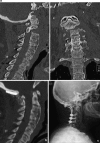Occipito-cervical fusion in post-traumatic instability of the upper cervical spine and cranio-cervical junction
- PMID: 24043340
- PMCID: PMC3830038
- DOI: 10.1007/s00586-013-3015-y
Occipito-cervical fusion in post-traumatic instability of the upper cervical spine and cranio-cervical junction
Abstract
Introduction: Surgical management of upper cervical spine (UCS) unstable injuries may be challenging as the number of cases requiring this surgery collected in every single center is small. This retrospective study was conducted to analyze the radiographic and clinical results in 12 patients undergoing a posterior occipito-cervical fusion by a polyaxial screws-rod-plate system.
Methods: There were eight male and four female patients with a mean age of 73.7 years (range 32-89 years). Six patients presented neurologic deficits at admission. Six patients had sustained major trauma. The remaining six patients had suffered a minor trauma.
Results: Two patients died postoperatively in Intensive Care Unit. All surviving patients achieved solid fusion at 6 months. No surviving patient had neurological deterioration postoperatively. There were no instrumentation failures or revision required. Two patients suffered from superficial occipital wound infection.
Conclusions: Although the indication to occipito-cervical fusion decreased since the new C1-C2 posterior fixation techniques were described, it remains a valid and reliable option in UCS post-traumatic instability to be applied even in emergency especially in the elderly.
Figures


References
-
- Wang JC, Mummaneni PV, Haid RW., Jr . Fixation options in the occipitocervical junction. In: Mummaneni PV, Lenke LG, Haid RW Jr, editors. Spinal deformity: a guide to surgical planning and management. St Louis: Quality Medical Publishing; 2008. pp. 223–240.
MeSH terms
LinkOut - more resources
Full Text Sources
Other Literature Sources
Medical
Miscellaneous

